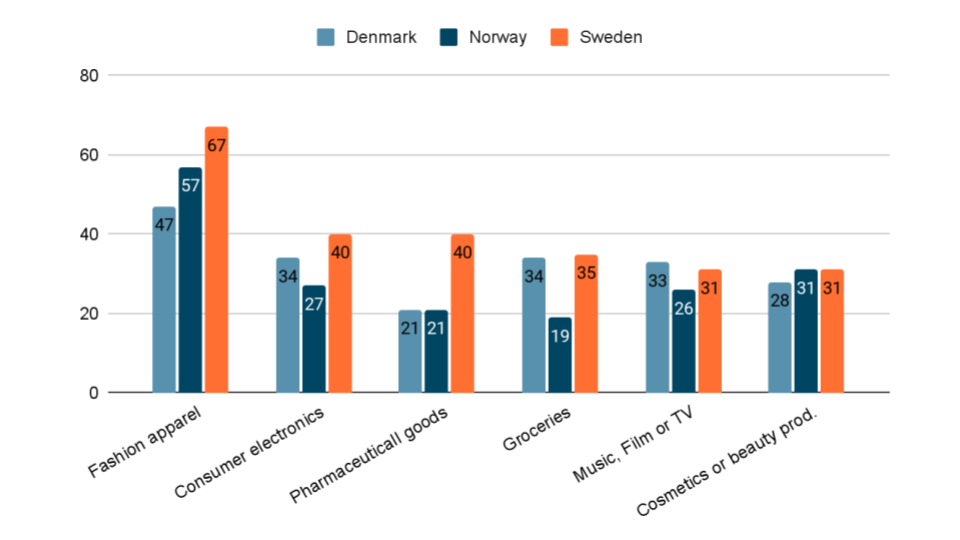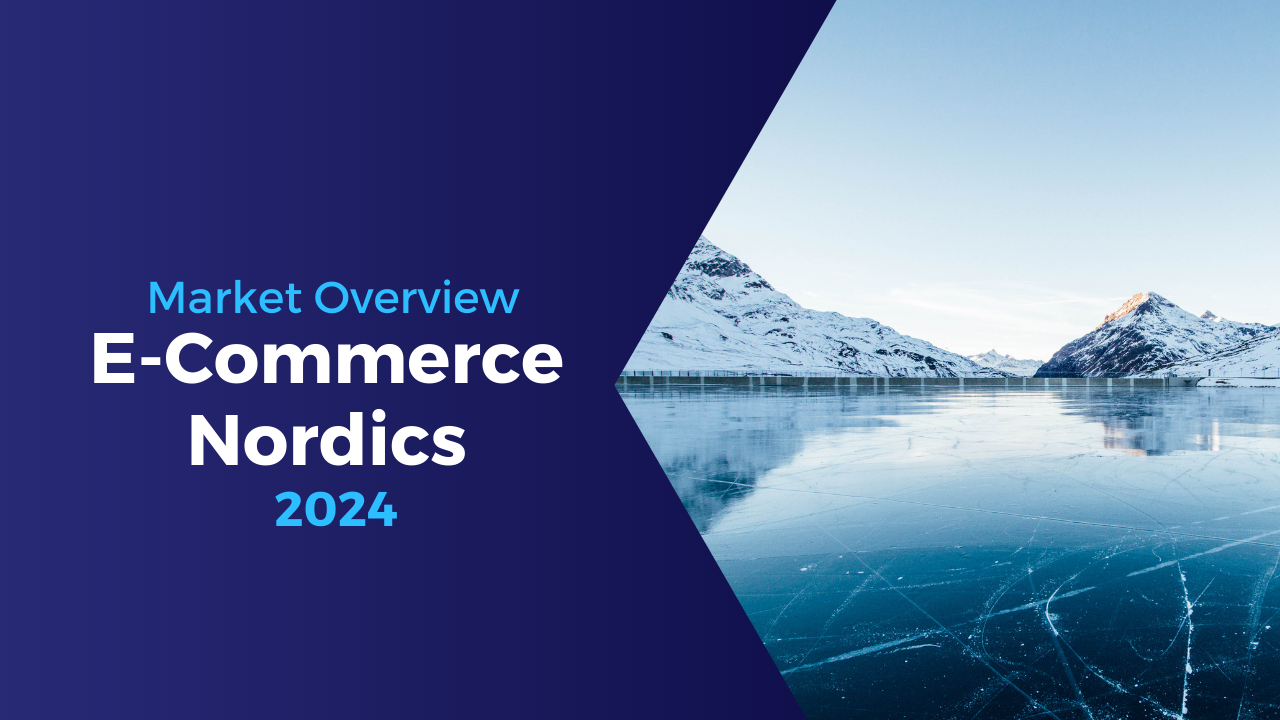Let’s dive into the world of e-commerce across the Nordic countries, encompassing Norway, Sweden, Finland, and Denmark. Industry analysts predict continued growth in the region’s total e-commerce revenue, driven by a surge in online shopping habits and a growing interest in diverse categories like groceries and home furnishings. Nordic consumers are known for their digital savviness, with a staggering 9 out of 10 actively participating in e-commerce. This digitally mature region boasts steady growth, exceeding $40 billion USD in 2023 and with projections reaching $56 billion USD by 2027. While Norway leads in terms of in terms of the percentage of its citizens that shop online, Sweden reigns supreme in e-commerce revenue, generating over $13 billion USD in 2022. It’s worth noting that Norway has an impressive 99% internet usage rate, with a remarkable 82% of its population actively shopping online. In total, Nordic consumers spent a staggering €37.4 billion online in 2022, highlighting the strength and vibrancy of the region’s e-commerce.
Shifting Tides in Nordic Shopping Habits
Pandemic-Driven Surge in Online Shopping
The COVID-19 pandemic significantly fueled a surge in online shopping across the Nordic region. A quarter of consumers credit the pandemic for their increased reliance on e-commerce, highlighting a broader trend of changing consumer behavior. These changes were undoubtedly accelerated by the challenges and adaptations brought on by the global health crisis.
Even before 2020, a gradual shift away from brick-and-mortar stores towards online platforms was underway, indicating a fundamental transformation in how Nordic consumers shop. This transition underscores a growing preference for the convenience and accessibility offered by digital channels. Sweden appears to be leading the charge, with 39% of consumers in June 2022 indicating they plan to spend more online in the future. Motivations for embracing online shopping are diverse, ranging from seeking better deals to valuing the overall convenience of the digital experience.
Nordic Consumers Embrace Borderless Shopping
The region stands out for its prevalence of cross-border e-commerce, with a staggering 80-90% of consumers participating. Well-established players like eBay, Zalando, and Amazon have made global online shopping seamless for Nordic consumers, fostering a taste for international brands and products. Looking ahead, Nordic consumers across Norway, Denmark, and Sweden anticipate continued growth in their online spending, reflecting a clear shift towards a digital-first shopping approach.
Fashion takes center stage when it comes to online purchases in the Nordic region. A significant portion of consumers – 47% in Sweden, 57% in Denmark, and a whopping 67% in Norway – have purchased clothing, shoes, or fashion accessories online in the past year. Sweden reigns supreme in online fashion sales, with a remarkable €3.5 billion spent in 2022. Furthermore, Norway boasts an impressive 25% of its total e-commerce revenue coming from cross-border transactions, highlighting the strong preference for international fashion options.
Current Market Trends in Nordics
Hold Your Horses, Amazon: Local Players Rule the Roost
The Nordic Countries’ e-commerce market presents a unique challenge for Amazon. Domestic powerhouses like Verkkokauppa in Finland and Elkjøp in Norway for consumer electronics hold a strong position. Gigantti, another omnichannel retailer with both physical and online stores, complements Verkkokauppa’s dominance in Finland. Sweden’s Clas Ohlson is another noteworthy player, boasting a substantial regional presence and offering a diverse range of homeware, accessories, and DIY products across physical stores and online platforms in Sweden, Norway, and Finland.
The Rise of Mobile and Niche Categories
The online shopping scene in the Nordics is booming, particularly in categories like home & garden and fashion. Retail apps are fueling this surge, with mobile purchases experiencing a significant leap from 32% to 45% across the region during the pandemic. Finland offers a glimpse into this trend, with toys, hobbies, and DIY products taking the top spot at 31% market share, followed closely by electronics and media at 23%. This highlights a growing consumer preference for the unmatched convenience of mobile shopping.

Sustainability Takes Center Stage and Cash Gets Left Behind
The Nordic region is a frontrunner when it comes to sustainable consumer practices. Heightened environmental awareness, particularly during lockdowns, has placed sustainability at the forefront of purchasing decisions. For example, a staggering 60% of Swedish women aged 65 to 79 prioritize eco-friendly choices. This focus on sustainability aligns with the broader goals of countries like Sweden, Denmark, and Finland, which all aim to be global leaders in environmental initiatives and achieve ambitious climate targets by 2030.
The Nordics are also leading the charge towards a cashless society, fueled by the prevalence of mobile shopping and the widespread adoption of mobile payment apps. Popular options like Swish in Sweden, MobilePay in Denmark, and Vipps in Norway have become the go-to payment methods for consumers. Cash usage has plummeted, dropping from 39% to a mere 9% between 2010 and 2020. This shift towards digital transactions reflects a preference for the convenience and efficiency offered by mobile payment solutions.
The Nordic E-Commerce Boom: Projections
Denmark leads the pack with a projected Compound Annual Growth Rate (CAGR) of 9.8% from 2023 to 2027, reaching a staggering US$14.65 billion. This growth is further fueled by a thriving Danish GDP, which saw a 0.2% increase in the first quarter of 2023, demonstrating their success in navigating energy market disruptions for a sustainable future.
Finland’s e-commerce market is poised to take off, with an estimated value of €12.74 billion by 2025, attracting over 4 million online shoppers. Despite potential recessionary concerns, Finland displays resilience with a projected GDP of €277 billion in 2023.
Norway is gearing up for its own e-commerce boom, anticipating revenues of €14.21 billion by 2027, driven by a robust 9.5% growth rate. Meanwhile, Sweden continues to be a major player, with a projected market volume of €21.79 billion by 2027, fueled by an impressive 9.4% CAGR.
Tech Trends Shaping the Future
The Nordic e-commerce landscape is not just about growth; it’s about embracing innovation. Several emerging technologies are poised to reshape the online shopping experience for Nordic consumers:
Immersive Shopping with AR and VR
Augmented Reality (AR) and Virtual Reality (VR) are revolutionizing the way people shop online. Imagine virtually trying on clothes or visualizing furniture in your living room – AR makes it possible! VR takes it a step further, offering 3D exploration of products and replicating the feeling of an in-store experience. With advancements and wider adoption, VR is expected to become a key tool for e-commerce businesses. Industry analysts like Forrester even predict a 50% increase in AR and computer vision applications in retail next year.
AI and Machine Learning: Powering Personalized Experiences
Artificial Intelligence (AI) and Machine Learning (ML) are more than just tech buzzwords – they are transforming e-commerce. These technologies personalize the shopping experience by analyzing user behavior and recommending products based on preferences. Imagine receiving targeted suggestions based on your browsing history! ML also helps businesses with inventory management, while AI-powered chatbots provide 24/7 customer support. The impact of AI is undeniable – the global AI market is projected to reach a staggering $2 trillion by 2030.
Blockchain: Building Trust and Transparency
Get ready for secure transactions and clear supply chains! Blockchain technology is emerging as a game-changer in e-commerce. This secure and decentralized system builds trust with customers while streamlining operations. Beyond ensuring safe transactions, blockchain offers a detailed record of a product’s journey, reducing fraud risks. Furthermore, it has the potential to revolutionize customer loyalty programs and create innovative marketplaces. The future of e-commerce is undoubtedly intertwined with the secure and transparent world of blockchain.
The Internet of Things: Blending E-Commerce
IoT is blurring the lines between e-commerce and daily life. Imagine your smart refrigerator automatically reordering milk when you’re running low, or your fitness tracker suggesting new workout clothes based on your activity levels. This is the power of IoT! These smart devices, from appliances to wearables, seamlessly connect to online platforms, offering a hyper-personalized shopping experience.
IoT devices can communicate with each other, creating a network of intelligent assistants. For example, a smart TV might recommend movies based on your recent viewing habits, while a connected fitness tracker could suggest new workout gear from your favorite online store. By bridging the digital and physical gap, IoT is poised to revolutionize the way we shop in the Nordic region, offering unprecedented convenience and personalization.
Thriving in a Tech-Driven World: A Guide for Nordic Businesses
The dynamic e-commerce landscape in the Nordics demands continuous adaptation. Here’s how businesses can embrace technological advancements:
Know Your Needs Before You Leap: Don’t get caught up in the latest tech trends. Start by identifying your specific business needs. Are you looking to boost efficiency, cut costs, or improve customer satisfaction? Once you understand your goals, you can determine the most suitable technology and the ideal timeframe for implementation. Involve your employees in this process – discuss how they envision using the technology and the improvements they expect.
Test, Test, Test: Technology can be a powerful tool, but rushing into implementation can backfire. Always conduct thorough testing before rolling out new software, hardware, or payment options. This helps identify and iron out any bugs or inefficiencies before they disrupt your business. Remember, investing time in upfront testing saves you time, money, and employee frustration in the long run.
Empower Your Workforce Through Training: New technology is only effective if your employees understand how to use it. Invest in hands-on training programs to equip your team with the skills they need to succeed. Regular training sessions, workshops, and even internal knowledge-sharing initiatives can foster a culture of collaboration and ensure a smooth technology transition. Consider a “train-the-trainer” approach – train a select group of employees first who can then instruct their colleagues.
By following these steps, Nordic businesses can leverage the power of technology to stay competitive and thrive in the ever-evolving e-commerce landscape.
Challenges and Opportunities
- Economic Pressures and Rising Costs: The Finnish Commerce Federation anticipates a slowdown in retail spending due to inflation and rising interest rates. This puts pressure on e-commerce businesses, as consumers have less discretionary income to spend online. Additionally, the growing demand for sophisticated customer data platforms (CDPs) to personalize the shopping experience can squeeze profit margins. Innovation and strategic thinking are crucial for businesses to navigate this economic environment.
- The Battle for Customers: E-commerce is a crowded space, and competition is fierce. Certain niches, like clothing and electronics dropshipping, are oversaturated with similar offerings. This intense competition leads to comparison shopping by consumers, who abandon carts in search of the best deals.
- Customer Retention: The Key to Success Acquiring new customers is expensive, but keeping existing ones is even more critical. Statistics show that selling to existing customers boasts a much higher success rate compared to new ones. Despite this, e-commerce businesses grapple with customer churn, with average rates ranging from 62% to 82%. Understanding the reasons behind customer churn and implementing effective retention strategies are essential for long-term success.
- Pricing and Shipping Strategies: Getting the price right is crucial. Shopify’s report reveals that 74% of consumers base their purchase decisions on price, yet only 12% of brands have a solid pricing strategy. Effective pricing considers factors like brand positioning and inflation. Shipping costs also present a challenge. Unlike e-commerce giants like Amazon, smaller businesses struggle to manage pricing and shipping efficiently.
Turning Challenges into Opportunities: Winning Strategies for Nordic E-Commerce
The good news is that these challenges can be overcome with the right strategies:
- Prioritizing customer satisfaction is the cornerstone of success. Here’s how:
- Target the right audience: Attract customers who truly value your offerings.
- Personalize the onboarding experience: Make new customers feel welcome and valued.
- Deliver exceptional customer service: Be responsive and address inquiries promptly.
- Create positive interactions: Surprise and delight your customers with unexpected touches.
- Monitor your competition: Stay ahead of the curve by understanding your competitors’ strategies.
- Building Customer Loyalty: Invest in initiatives that build trust and encourage repeat business:
- Invest in customer support: Provide excellent customer service representatives to address inquiries and resolve issues efficiently.
- Listen to your customers: Conduct regular user feedback surveys to understand their needs and expectations.
- Offer flexible payment options: Cater to diverse preferences by providing a variety of payment methods.
- Master Pricing and Shipping:
- Develop a data-driven pricing strategy: Use tools like Prisync to track competitor pricing and set prices that are competitive yet profitable.
- Strategically use promotions: Employ targeted discounts, coupon campaigns, and bundle pricing to improve conversion rates.
- Optimize shipping costs: Partner with local couriers for better rates and explore e-commerce platform plugins that streamline label printing and shipping calculations.
By focusing on customer satisfaction, building loyalty, and implementing smart pricing and shipping strategies, Nordic e-commerce businesses can not only navigate challenges but also unlock new opportunities for growth.



